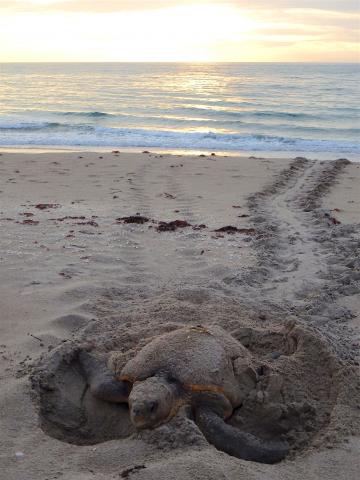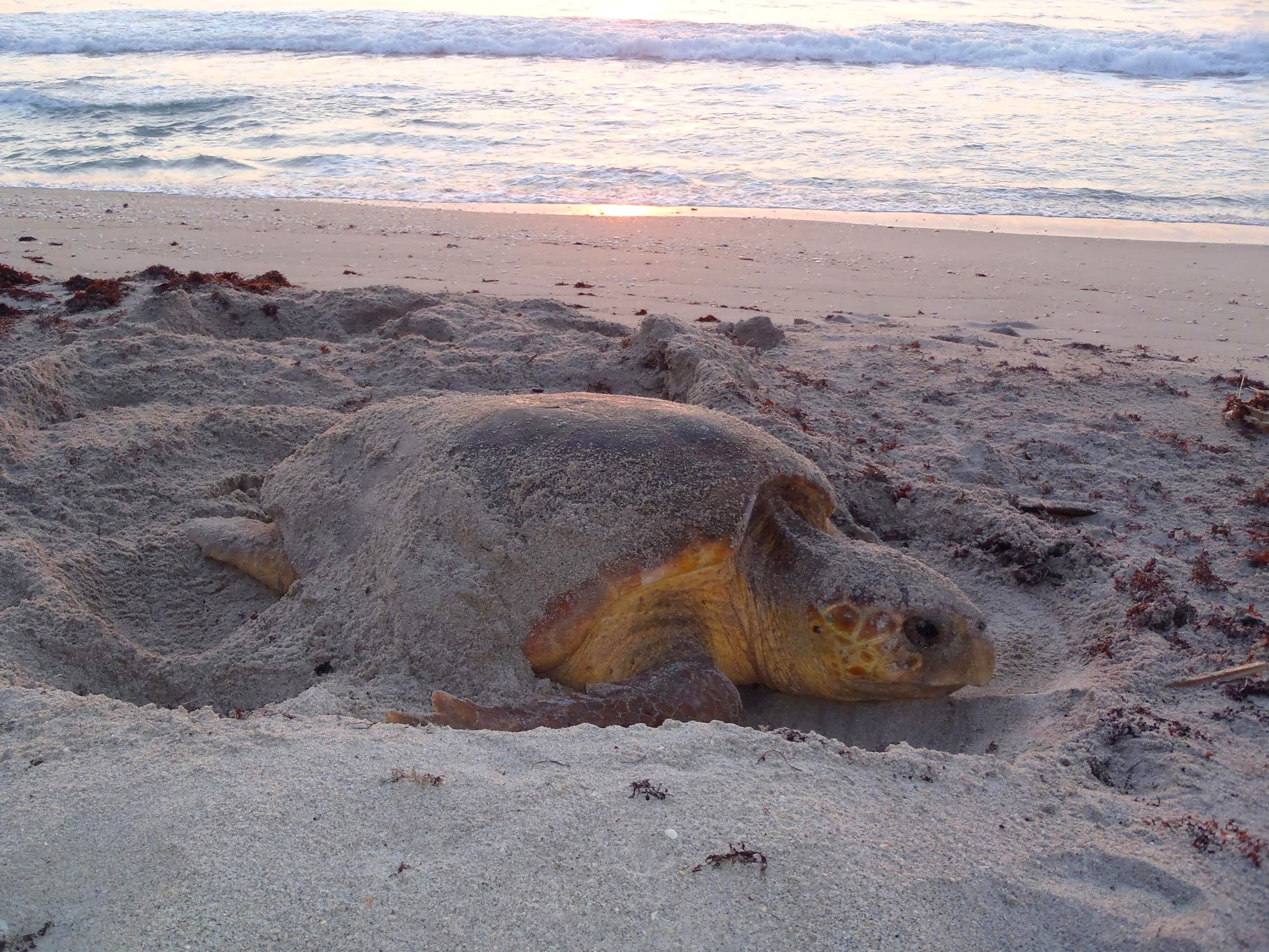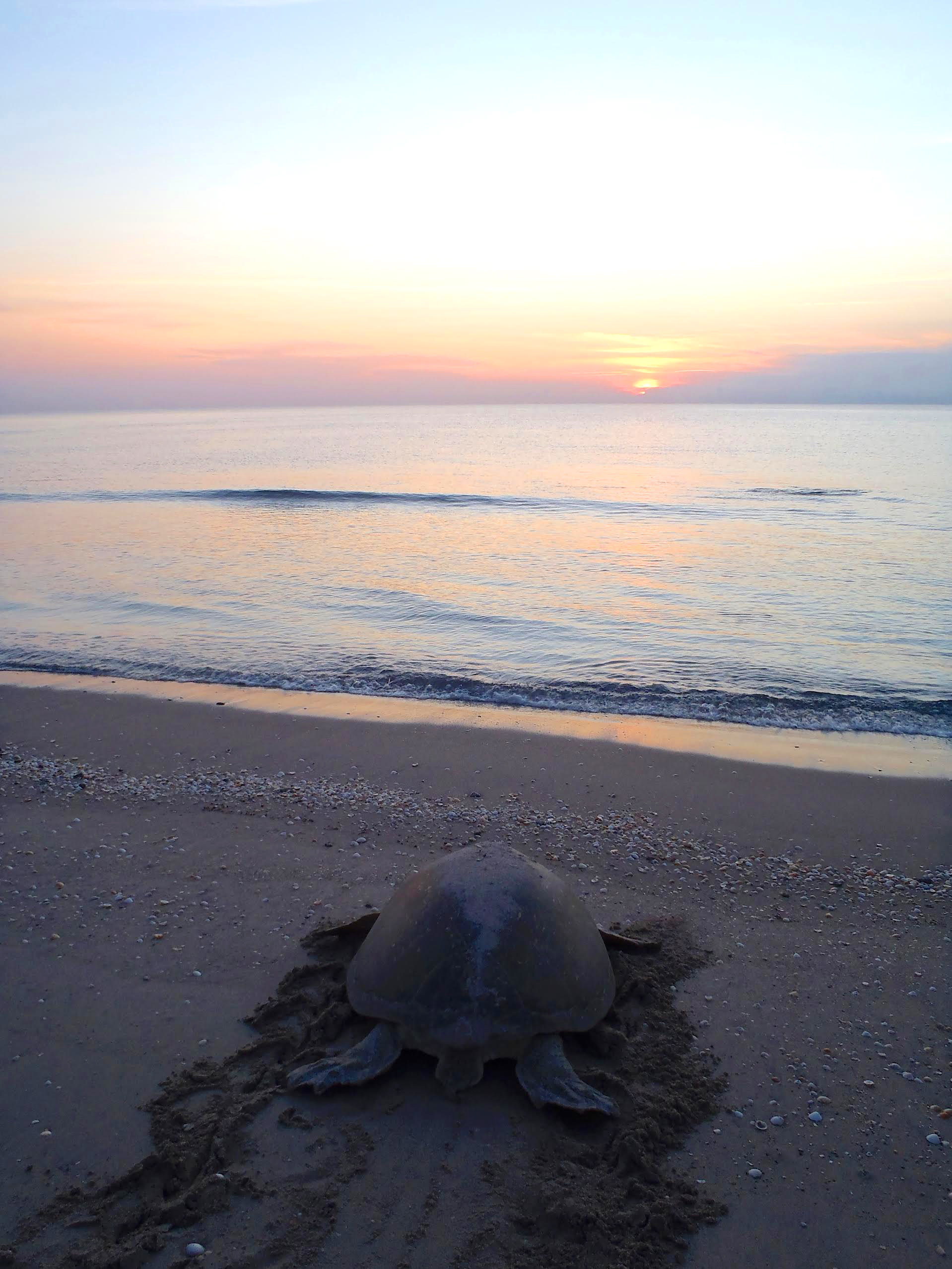Sea Turtle Nesting Season is Heating Up!
Residents of the Treasure Coast are fortunate to share their beaches with enormous prehistoric reptiles that have been cruising earth’s seas since the time of the dinosaurs. While sea turtle nesting season in Florida officially runs from March 1 to October 31, the number of nesting turtles visiting our beaches will really start to pick up in May.
All sea turtles that use Florida’s waters and beaches are protected by the Endangered Species Act and the Marine Turtle Protection Act. Unfortunately, poaching, egg harvest, marine pollution, boat collisions, and unsafe fishing practices are taking a toll on sea turtles globally. In Florida, habitat loss is one of the biggest threats facing sea turtles. Beach nourishment and waterfront development can disrupt nesting, and the loss of more than 50,000 acres of seagrass in the Indian River Lagoon during the last decade has eliminated critical nursery habitat for young turtles. From the perspective of a sea turtle, our coastlines have definitely changed for the worse over the last 80 years (the typical lifespan of a sea turtle). While many of the bigger issues facing sea turtles are out of our control, by keeping turtle nesting beaches dark, flat, clean, and desolate, we can all do our part to help conserve a group of animals that was on the brink of extinction just a few decades ago.
Dark Beaches – Don’t light the way
Nesting mother sea turtles and newly emerged hatchlings are easily disturbed by artificial lighting on the beach. This includes flashlights, camera flashes, video lighting, lanterns, bon fires, tiki torches – even the glow from a smartphone screen. Mother turtles prefer to nest on dark beaches. The sudden appearance of artificial lighting will often frighten a nesting turtle back into the ocean, resulting in a “false crawl.” While most turtles will attempt to nest again after a false crawl, a scared and exhausted mother will sometimes abandon her eggs in the ocean – something we want to avoid. Artificial lighting can also disorient emerging hatchlings as they scamper towards the surf, causing them to head in the wrong direction. Every year, we hear sad stories of disoriented hatchlings ending up in pools, parking lots, and even the middle of A1A. If you live on the beach, your home lighting can have a huge impact on the turtles that nest behind your property. During turtle nesting season, turn off outdoor lights and close your blinds at night to limit light spilling onto the beach. If you just can’t live without outdoor lighting, please use turtle-safer bulbs and fixtures that are less visible to nesting turtles.
Flat Beaches – Easy Access
Sea turtles don’t have the biggest brains, but 100 million years of evolution has given them incredible instincts. Today, Florida’s beaches are mostly free of large predators that might threaten a nesting sea turtle. However, mother turtles are still extremely sensitive to anything on the beach that might resemble a predator. Things like sand castles and beach furniture can frighten a mother turtle back into the water, resulting in a false crawl. Beach furniture can be more than just scary for a nesting turtle. Particularly determined mother turtles have even become entangled in beach furniture during their nesting journey. At the end of every beach day, flatten sand castles, fill in holes (which can trap turtles), and bring in all furniture.
Clean Beaches – Trash and Turtles
Trash and sea turtles can be a lethal mix. Sea turtles regularly mistake floating bits of plastic for food. Roughly 75% of sea turtles admitted to turtle hospitals in Florida have plastic in their stomachs. Some of the biggest culprits are plastic bags and balloons, but countless other plastic items have been removed from the stomachs of rescued sea turtles. Make sure your day at the beach doesn’t have deadly consequences for a sea turtle. If a piece of trash blows away, make an effort to chase it down. Even a tiny scrap of plastic can be lethal to a sea turtle hatchling. See someone else’s garbage on the beach? Lead by example and help it find its way into a trash can.
Desolate Beaches – Turtles need their space
For the sake of our sea turtles, it’s best to steer clear of the beach at night during nesting season. Your presence alone could be enough to cause a mother turtle to abandon her nest and crawl back to the ocean. Please don’t try to observe nesting turtles on your own. Instead, join a guided and permitted sea turtle nesting walk led by a nature center like Florida Oceanographic Society. If you do come across a turtle on the beach at night, give her plenty of space. Resist the urge to approach her – your actions might cost a mother turtle her entire clutch of eggs. Remember – it’s against the law to disturb or disrupt the behavior of a nesting sea turtle. This includes the obvious, like touching, holding, petting, harassing, and flash photography, but also less obvious actions like scaring a mother by approaching too closely. If you like to fish on the beach at night during the summer, please try to minimize your use of light, maintain a small footprint, and keep your voices down. While red flashlights are sometimes billed as “turtle safer,” these lights can still disturb turtles, so please keep their use to an absolute minimum. And by all means, leave your pets at home. Dogs can scare mother turtles back into the water, dig up nests, and eat hatchlings! If you witness a potential violation of a sea turtle law, don’t hesitate to call 911. Our local and state law enforcement agencies take these issues very seriously.
In honor of Sea Turtle Month at Florida Oceanographic Society, consider adopting a sea turtle to help support the four permanently disabled sea turtles that call our Coastal Center their “forever home.” Visit https://www.floridaocean.org/adopt-animal to learn more about our animal adoption program. All proceeds go directly towards the care of our animals.
Zack Jud, Ph.D., is the Director of Education at Florida Oceanographic Society. He can be reached at [email protected]

A mother loggerhead sea turtle covering her nest as the sun rises.
(Photo Credit: Mary Wozny)

Early morning beach walkers may luck out and stumble upon a late nesting turtle, like this loggerhead.
(Photo Credit: Mary Wozny)

A green sea turtle returning to sea after successfully nesting.
(Photo Credit: Mary Wozny)
